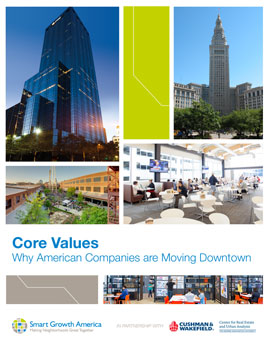Two or three decades ago, the standard criteria for choosing an office location was often, "Where does the boss live?” says land use strategist Christopher Leinberger. And the boss inevitably lived in a car-oriented suburb.
But the tide’s been shifting for a while now, with more American companies ditching suburban office parks for downtown locations. In 2013, Zappo’s chose to head to the center of Las Vegas, setting up shop in the former City Hall building. Biogen, a global biotech firm, tried out the Boston suburbs for four years before moving back to the heart of Cambridge in 2014. In downtown Raleigh, software firm Citrix recently took over an abandoned warehouse just three blocks from the Amtrak station.
Smaller companies are doing it, too, in smaller urban areas. In Conway, Arkansas, this year, Big Cloud Analytics opened a two-person office, pinning their company’s expected growth to the downtown's projected resurgence.
A new report from Smart Growth America, "Core Values: Why American Companies Are Moving Downtown" [PDF], takes stock of this trend over the past five years and seeks to understand what motivates these companies to choose central locations.
George Washington University’s Center for Real Estate and Urban Analysis and the real estate firm Cushman & Wakefield surveyed 500 companies that made the move downtown and interviewed executives at 45 of them. It was like a “giant focus group looking at why people are doing this,” said Leinberger, who helped guide the report. An interactive map shows where these companies are relocating.
The survey identified a few key factors underlying the move downtown. The biggest one is an increased ability to recruit and retain employees -- companies are finding they get a competitive edge with an office in an accessible, walkable location.
“We’re able to show potential employees a cool office in the middle of downtown and that has definitely helped us recruit people,” said Adam Klein of American Underground, a computer programming firm that in 2013 moved into a former tobacco factory in downtown Raleigh. He says employees appreciate being able “to walk to get a cup of coffee and participate in the arts, music, and the excitement of downtown.”
Of course, downtowns are seen as a draw particularly for Millennials, who now make up the largest generational segment of America’s workforce. They think "it’s boring as all get out" in a suburban office park, said Reg Shiverick of Dakota Software, located in downtown Cleveland.
The sense of being literally at the center of things can also help a company project a spirit of innovation and creative collaboration. TakeLessons, a firm that connects people to tutors, is nestled among a hub of more than 20 other startups in downtown San Diego. “That kind of camaraderie doesn’t happen in places where your closest colleagues are a 15 minute drive away,” said CEO Steve Cox.
The report notes that despite the visibility and chatter surrounding the movement of companies to central locations, the majority of jobs in America remain located outside of downtowns. Researchers yesterday pointed to some glaring exceptions to the urban trend, like Apple’s new “spaceship” headquarters, which is being developed next to a forest in Cupertino.
In some cases, cities extended tax breaks or other incentives to woo employers. Fewer than half the companies surveyed, though, received direct financial assistance. And researchers found that pure dollars-and-cents incentives didn’t figure prominently into most moves downtown, Cushman & Wakefield’s Paula Munger said in a telebriefing yesterday.
But the convenience of downtown does tend to help with other practical matters, like accessibility to clients and business partners. Across the study sample, the companies’ Walk Score jumped an average of 36 points with their moves. A central spot also makes sense when companies are trying to consolidate multiple offices in one metro region.
As far as the higher costs of a downtown location, researchers say the other benefits appear to outweigh them. And as Leinberger emphasized, higher rents reflect pent-up demand. “That’s the market saying, build more stuff."





